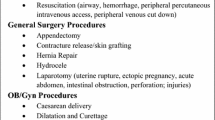Abstract
Background
There are few established metrics to define surgical capacity in resource-limited settings. Previous work hypothesizes that the relative frequency of cesarean sections (CS) at a hospital, expressed as a proportion of total operative procedures (%CS), may serve as a proxy measure of surgical capacity. We attempted to evaluate this hypothesis as it specifically relates to hospital capacity for emergency interventions for injury.
Methods
We conducted a WHO survey of emergency surgical capacity at 40 Rwandan district hospitals in November 2010 and extracted annual operative volume for 2010 from the Ministry of Health centralized statistical system. We dichotomized the 40 hospitals into low and high %CS groups below and above the median proportion of CS performed. We compared low and high %CS groups across self-reported capabilities related to facility characteristics, trauma supplies, procedural capacity, and surgical training using bivariate χ2 statistics with significance indicated at p ≤ 0.05. We evaluated herniorrhaphy proportion of total procedures (%Hernia) as a representative general surgery procedure in the same manner.
Results
High %CS hospitals were less likely to report capability related to blood banking (p = 0.05), amputation (p = 0.04), closed fracture repair (p = 0.04), inhalational anesthesia (p = 0.05), and chest tube insertion (p = 0.05). Availability of reliable electricity was the only measure that showed statistical significance with the %Hernia measure (p = 0.02).
Conclusions
Cesarean section proportion shows some utility as a marker for district hospital injury-care capacity in resource-limited settings.

Similar content being viewed by others
References
Farmer PE, Kim JY (2008) Surgery and global health: a view from beyond the OR. World J Surg 32(4):533–536
Ozgediz D, Riviello R (2008) The “other” neglected diseases in global public health: surgical conditions in sub-Saharan Africa. PLoS Med 5(6):e121
Bickler SW, Spiegel DA (2008) Global surgery—defining a research agenda. Lancet 372(9633):90–92
Weiser TG, Makary MA, Haynes AB et al (2009) Standardised metrics for global surgical surveillance. Lancet 374(9695):1113–1117
Weiser TG, Regenbogen SE, Thompson KD et al (2008) An estimation of the global volume of surgery: a modelling strategy based on available data. Lancet 372(9633):139–144
World Health Organization (WHO) situational analysis tool. www.who.int/entity/surgery/publiations/QuickSitAnalysisEESCsurvey.pdf. Accessed 24 Nov 2009
Kingham TP, Kamara TB, Cherian MN et al (2009) Quantifying surgical capacity in Sierra Leone: a guide for improving surgical care. Arch Surg 144(2):122–127 (discussion 128)
Osen H, Chang D, Choo S et al (2011) Validation of the world health organization tool for situational analysis to assess emergency and essential surgical care at district hospitals in Ghana. World J Surg 35(3):500–504
Kushner AL, Groen RS, Kingham TP (2010) Percentage of cesarean sections among total surgical procedures in sub-Saharan Africa: possible indicator of the overall adequacy of surgical care. World J Surg 34(9):2007–2008
Petroze RT, Nzayisenga A, Rusanganwa V et al (2012) Comprehensive national analysis of emergency and essential surgical capacity in Rwanda. Br J Surg 99(3):436–443
Ozgediz D, Kijjambu S, Galukande M et al (2008) Africa’s neglected surgical workforce crisis. Lancet 371(9613):627–628
Ozgediz D, Hsia R, Weiser T et al (2009) Population health metrics for surgery: effective coverage of surgical services in low-income and middle-income countries. World J Surg 33(1):1–5
Kruk ME, Wladis A, Mbembati N et al (2010) Human resource and funding constraints for essential surgery in district hospitals in Africa: a retrospective cross-sectional survey. PLoS Med 7(3):e1000242
Rasch V (2007) Maternal death and the Millennium Development Goals. Dan Med Bull 54(2):167–169
Pitt C, Greco G, Powell-Jackson T, Mills A (2010) Countdown to 2015: assessment of official development assistance to maternal, newborn, and child health, 2003–08. Lancet 376(9751):1485–1496
Ministry of Health (MOH) [Rwanda] NISR, ICF Macro (2006) Rwanda demographic and health survey 2005. MOH, NISR, and ICF Macro, Calverton
National Institute of Statistics of Rwanda (NISR) [Rwanda], Ministry of Health (MOH) [Rwanda], ICF International (2011) Rwanda Demographic and Health Survey 2010. NISR, MOH, and ICF International, Calverton
Acknowledgments
The authors thank the Ministry of Health (MOH) of Rwanda, particularly Dr. Vincent Rusanganwa and the HMIS division, for assistance in implementation of the survey and access to surgical volumes at the district hospitals. Work was conducted in Rwanda with ethical approval from the University Teaching Hospital-Kigali. Work was funded by a Fogarty International Clinical Research Fellowship, National Institutes for Health and International Clinical Research Fellows Program at Vanderbilt University, USA (R24 TW007988).
Author information
Authors and Affiliations
Corresponding author
Rights and permissions
About this article
Cite this article
Petroze, R.T., Mehtsun, W., Nzayisenga, A. et al. Ratio of Cesarean Sections to Total Procedures as a Marker of District Hospital Trauma Capacity. World J Surg 36, 2074–2079 (2012). https://doi.org/10.1007/s00268-012-1629-6
Published:
Issue Date:
DOI: https://doi.org/10.1007/s00268-012-1629-6




